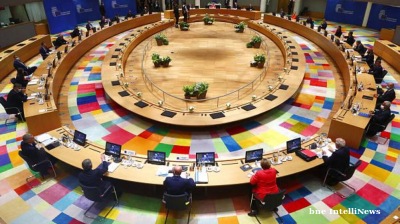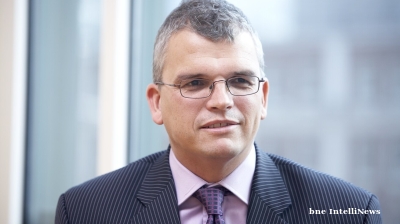“We have no serious problems. The macroeconomic fundamentals are solid. Really all we have to do now is manage the economy to improve stability and promote growth,” Mirsaid Nosirov, an analyst at the Central Bank of Uzbekistan (CBU), told bne IntelliNews during a trip to Tashkent.
The Uzbek economy was one of only two major economies in the world that didn't go into recession in 2020. It was hurt like everyone else in the pandemic. No one escaped the shock of a global pandemic. But thanks to the new market-oriented prudent management and the robust growth Uzbekistan has been enjoying since Uzbek President Shavkat Mirziyoyev took over in 2016, the economy had enough momentum to plough through the storm.
Uzbekistan has a lot going for it. The economy has been booming on the back of simply liberalising the rules over the last five years. Locked up by the former, and only other, president Islam Karimov, just opening the gates again has allowed companies to do business. All of the easy catch-up growth most countries of the Former Soviet Union (FSU) have enjoyed in the last three decades remains ahead for Uzbekistan.
Before the pandemic hit, GDP was rising by more than 6% a year. But in 2020 that fell to a mere 1.7% before bouncing back this year, returning to 6.9% in the first nine months of this year compared to the same period a year earlier, according to the Central Bank of Uzbekistan (CBU).
The main drivers of growth include: increases in information and communications (21.6%), manufacturing (14.2%), hospitality and dining (17%), transportation and storage (16%) and wholesale and retail trade (10.9%). The only sector that contracted was banks and finance (-0.9%) according to the official figures.
Retail and incomes
However, the population remains poor. GDP per capita for the first nine months of this year was UZS14.9mn ($1,402), up 4.9% year on year and up by a third from 2019, but still less than a sixth of Kazakhstan’s GDP per capita of $9,055.
Things are getting better as the catch-up unfolds. That is driving growing consumption and that in turn is a powerful stimulus for economic growth. Retail turnover reached UZS167,026bn ($15.6bn) in the first nine months of this year, reports investment bank Bluestone, up 9.8% on the same period a year earlier.
Small and medium-sized enterprises (SMEs) make up three quarters of all the retail business and saw volumes increase by 6.9%, while large enterprises expanded by a little more, up 13.1% in the same period, but the biggest gains were in the informal sector (32.8%).
As of October 1 there were 472,273 SMEs (excluding farms) operating in Uzbekistan, up by a fifth from a year earlier, and more than 2.3 times the number in 2016, when Mirziyoyev took over the helm. The new president's liberalisations have created a much more fertile business climate for small entrepreneurs, which were generating about $2.3bn worth of goods and services in 2020, according to official statistics.
Although much of business remains small-scale, the make-up of the economy is already fairly well balanced, with services accounting for 38.7% of GDP, agriculture 26.9%, industry 27.6% and construction 6.8%, according to the official statistics.
As the economy returns to health the international financial institutions (IFIs) have upped their forecasts for this year. The International Monetary Fund (IMF) revised its outlook for 2021 to 6.1% and for 2022 to 5.4%. The World Bank is predicting 6.2% for 2021 and 5.6% for 2022. And the Asian Development Bank (ADB) is a little more cautious, with a prediction of 5% growth this year and 5.5% for next year.
In addition to retail, a construction boom is adding to the growth impetus, posting a 4.5% y/y growth in the first nine months of this year after expanding only 0.1% in the first half of this year. Cement production, a proxy for construction growth, increased by 18.2% y/y to 8mn tonnes in the first eight months of this year and is knocking on to the leading cement producers like Qizilqumsement (QZSM), which is investing heavily into expanding its production.
Tashkent remains the epicentre of the construction boom, but construction is mushrooming in several other regional cities, including Khorezm (32.4%), Syrdaryo (23.6%) and Kashkadaryo (20.2%). The total value of construction projects in the entire country reached UZS76,891bn ($7.2bn) in the first nine months of this year, according to the Uzbek State Statistics Committee.
Inflation
The bugbear is, as for most of the countries in the Commonwealth of Independent States (CIS), inflation that has been driven up by the faster than expected post-coronavirus (COVID-19) bounce-back and soaring food prices. The introduction of inflation targeting is now the main focus of the CBU, which is trying to anchor the population’s expectations for price rises.
After the centralised controls on the economy were eased in the first quarter of 2020 inflation has been falling from a steady 15.5% to reach a low of 10.7% in April 2021 that allowed the CBU to make a series of rate cuts.
Since the pandemic broke out inflation has been remarkably contained and after rising to 11.1% during the worst of the crisis it has fallen back to 10.8% as of September. However, the CBU has refrained from more rate cuts, although it hasn't had to hike rates either, choosing to leave them on hold at 14% at its last policy meeting in October.
“The inflation rate [in September] was slightly higher than the CBU baseline forecast and was driven primarily by the increases in the prices of food products, although the rate of food inflation slowed in September. Core inflation was recorded at 9.2%, down 3% since the beginning of 2021,” says the Tashkent-based Bluestone investment bank.
Long-term, massaging inflation down is one of the biggest challenges for the CBU, which has only recently introduced its inflation targeting policy. The regulator forecasts inflation falling to 9% in 2022 then to 7%, 6.5% and 6% each year in the next three years. The CBU intends to cut rates each year to 12% in 2022 then to 10%, 9% and 9% in each of the following three years.
But the challenges for the CBU remain manifold. The basic problem the central bank faces is that having lived through decades of economic chaos the population has little confidence in the central bank and the inflation expectations of the population and businesses have never been anchored. The expectations for price rises remain significantly higher than those of the CBU forecasts, which is itself inflationary.
“We introduced inflation targeting in 2020 and we are now creating the tools,” says the CBU’s Nosirov. “Inflation has fallen to 10.8% in December from 11.1% in 2020 and 15.2% in 2019. The pandemic helped reduce inflation as it depressed agricultural demand, but the fast recovery since then has reacted new inflationary pressures. Now we are focused on getting inflation under 11% again and have a medium-term target of 10% with a long-term forecast of 9%... Overall we regard inflation to be stable.”
In addition to the high expectations, more immediately global food prices have been soaring and this year a poor harvest in Russia will keep prices high. And Uzbekistan has the highest rate of inflation in the region.
On the flip side the global boom in commodity prices has been a boon, particularly as gold prices – something else Uzbekistan produces – have risen strongly in recent years.
Inflation is being exported from surrounding countries as several of Uzbekistan’s neighbours have started to limit or tax exports of commodities like fertiliser, grain and vegetable oil, which have also driven prices up on the domestic market as supplies become restricted.
Uzbek food prices in September were up 14.4% y/y, although that was down slightly from the 15.5% in August as supply chains are repaired and the autumn harvest starts to come in, but fruit and veg didn't experience its typical seasonal declines this year. Happily the prices for non-food products have been less affected and were already falling more noticeably, from 9.1% in February to 7.7% in September.


Rates mismatch
High inflation causes another problem that will fade as price rises are brought under control. High inflation means the CBU has to keep its monetary policy rate relatively high; however, banks with access to dollar funding can afford to offer significantly low rates on dollar loans. The spread between the cost of borrowing in soum and dollars is so wide that most borrowing is done in foreign exchange that exposes Uzbek companies to significant FX risks.
“The dollar share of loans is currently 48%, but there is a gradual decline,” says Nosirov. “There is still a big interest rate differential.”
With retail deposits paying 17.5% and loans costing 21% in soum there is a 3-4% spread that remains a disincentive for business to borrow for investment capital in the local currency. However, Nosirov points out that the soum has been very stable and only devalued against the dollar by 2% in the first nine months of this year.
“But it will take time for this differential to fade,” says Nosirov. “We have only just started the inflation targeting policies. It's a new mentality but we already see that it’s having an effect.”
The central bank has to be worried by the dollarisation of credits as other countries, like Ukraine and Poland, have come a cropper in the past by exposing themselves too big FX risks. The share of dollar loans has already started to fall from 70% previously to 50%:50% local vs foreign exchange now.
“It's changing now thanks to the stable currency and the falling inflation,” says Nosirov. “But it will take several years to normalise.”
Plov index
In order to get a better handle of how prices rises hurt the most vulnerable sections of society the Uzbek State Committee has set up the “plov index”, an equivalent of the Economist magazine’s famous Big Mac index to track prices, that also has a Russian equivalent, the borscht index.
All these indices do is track the prices of the most basic food – a burger, or in Russia’s and Uzbekistan’s cases, the cost of the ingredients needed to make the most popular staples. Plov is the national dish and made of lamb, rice, yellow carrots, onion, garlic and vegetable oil. Changes in the cost of a portion of plov have the most direct impact on a household’s income.
The statistics committee publishes the monthly cost of a kilo of plov in all the regions as an alternative to measuring inflation and the cost of one portion of plov in Tashkent in September has gone up by 30.4% y/y compared to an increase of 10.7% for headline inflation in the same period.
The plov index shows that those at the lower end of the income bracket are disproportionately hurt by rising food prices, which is another reason why inflation expectations have become unanchored and are significantly higher than the CBU forecast for the headline inflation rate.

External trade
The final piece in the macroeconomic puzzle is Uzbekistan’s improving foreign trade balance. Since the foreign exchange currency liberation in 2017, dismantling the harsh systems of controls imposed by Karimov, companies have leapt at the chance to do their own export deals and trade is flourishing.
Without the hydrocarbons that bless the economies of Kazakhstan and Turkmenistan, Uzbekistan continues to run a trade deficit that reached $7.6bn in the first nine months of this year on exports of $10.3bn and imports of $17.9nm. The total trade turnover was $28.2bn, a 2.5% increase y/y in the period, after the turnover bounced back by over a half (54%) in the first half of the year as coronavirus restrictions were lifted.
“About 40% of our imports is equipment but a lot of that comes from China, where inflation remains stable so the import of inflation effect has been muted,” says Nosirov.
China remains Uzbekistan’s most important trade partner, but turnover with its ancient partner has still not regained pre-pandemic levels, whereas trade with the other Central Asian republics and Turkey has surpassed 2019 levels, the last year of strong growth.
Uzbekistan’s trade with the other CIS countries in the first nine months of this year was up 28.7% y/y, while its trade with non-CIS countries further afield is down by 9.1% in the same period, and trade with these other countries make up almost two thirds (61.6%) of the republic’s trade, according to the state statistics service.
To improve the balance of payments equation the government is fully focused on investing into adding value to production. Uzbekistan’s biggest export item is now textiles, which is a reflection of the state’s new policy of aggressively targeting value added exports following the complete ban on raw cotton exports, which has forced cotton growers to invest into textile production.
Textile exports were worth $2.1bn in the first nine months of this year. The ban on raw cotton exports has worked, with textile exports soaring by 58.3% y/y in the first three quarters. Moreover, new trade deals are opening up new markets: in April Uzbekistan won the coveted preferential trade status with the EU that allows it to export textiles to Europe with no duties and no quotas, allowing volumes to more than double in less than a year.
Features

Europe remains Russia's number one biggest importer of gas, top five importer of oil in August
US President Donald Trump complained that the EU is still importing too much Russian oil and that the White House will not put sanctions on Russia unless the EU cuts back on this business.
_1758174730.jpg)
Indonesia’s Raja Ampat - tourism hub or den of corruption?
In recent years, Indonesia has doubled down on promoting Raja Ampat, a remote archipelago in West Papua famed for its biodiversity, as a global eco-tourism icon.

Flood corruption scandal shakes the Philippines
The Philippines is grappling with a widespread controversy surrounding its flood control programme, with allegations of billions of pesos being siphoned off from projects meant to protect vulnerable communities.

The European Commission proposes to “creatively” tap Russia’s $300bn of frozen assets with Reparation Loans
The European Commission is floating a new idea of how to “creatively” tap Russia’s $300bn of frozen assets without the need to appropriate, which is legally questionable, by replacing the money transferred to Kyiv with EU-backed bonds.



